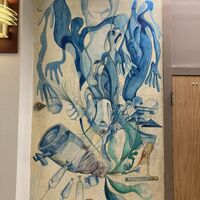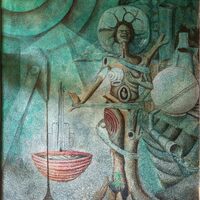-
 Birth of the Expression
Birth of the Expression Burley’s mural explores cycles of life and centers women. The left side conveys night, with a constellation of a woman stretching across the sky. The right side shows daytime, with natural imagery of a horse, corn, and cotton. A rainbow stretches across the whole mural, signifying unity and togetherness. This is reminiscent of Biggers’ "Web of Life."
-
 Family Scene
Family Scene Sifuentes' shows multiple generations of a family, painted in a geometric style. The scene depicts parents and grandparents caring for children, with deceased ancestors (painted with angel wings) looking over them. Sifuentes borrows visual symbols from Dr. Biggers in this piece, including the tortoise (longevity) and the serpent (danger).
-
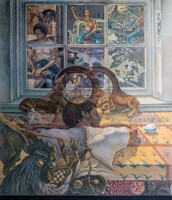 My Life After the Death of My Mother
My Life After the Death of My Mother Samples’ mural unfolds like a dream, with each panel above the central figure (the artist himself), who is asleep on a table, revealing a constellation of scenes from the artists’ youth. Lower window panels evoke a harmonious existence with nature and animals, while upper panels reveal struggles with racism in the South and his mother’s death.
-
 The Rape of Mother Nature
The Rape of Mother Nature Jones’ mural shows an image of Mother Nature being attacked by oil derricks, pollution, and industrialization. This piece was painted during an explosion of oil drilling expansion throughout Texas. Nature is essential to Jones’ artistic practice; nowadays he creates wood carvings with reclaimed lumber from trees that fall during storms.
-
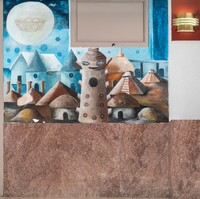 Architecture
Architecture Lacy’s mural illustrates houses from a variety of different civilizations and cultures. The center structure which appears to have a face is a depiction of the terracotta sculpture she created under the instruction of Professor Carroll Harris Simms. In the upper left there is a moon with a basket of eggs, symbolizing fertility and new life.
-
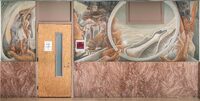 Awakening
Awakening Gordon’s mural shows the artist in various stages of her creative process, reflecting the influence of her TSU art professors. In the composition, she portrays herself sculpting a terracotta bison, throwing pottery at a wheel, weaving at a loom, and drawing at an easel. A wispy fabric runs through the mural, a motif in some of her other works.
-
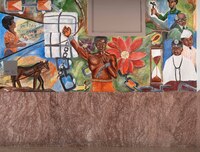 [unknown]
[unknown] This mural by an unknown student artist reflects themes of emancipation and progress. The central figure of a shirtless Black man raises his fist, while broken chains dangle from his waist. Bales of cotton and chains signify slavery in the mural, while, on the right, Black men in various professions represent changes brought by emancipation.
-
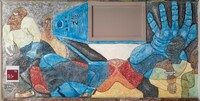 [unknown]
[unknown] Jones’ surrealist Hannah Hall mural depicts bald, one-eyed men conducting a television broadcast. The artist incorporated Hannah Hall’s architecture into the design, as the beige panel, where the camera lens would be, was a glass transom window when the mural was painted. Dr. Biggers urged students to carefully consider where to paint their murals.
-
 [unknown]
[unknown] Mills’ Hannah Hall mural reflects on white supremacist violence in the US and Black activism. Key political figures like Martin Luther King, Jr., Stokely Carmichael, John F. Kennedy, and Robert F. Kennedy appear throughout the mural. In the center, a man either lifts or pulls down the American flag to reveal or conceal hidden white supremacists.
-
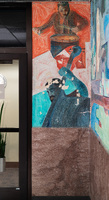 [unknown]
[unknown] Heliton's mural captures the emotion and environment of a mid-20th century jazz club. Vocalists, a bassist, trumpeters, and a saxophonist are depicted in a fervent state of artistry. Heliton chose a corner spot for his mural, which lends a sense of depth to the piece, similar to how a jazz band would be physically arranged.
-
 The Castration of Humanity
The Castration of Humanity Davis’ mural is a commentary on the conflict between technology & progress and history & culture. African statues are shown with their genitalia replaced by machines. Davis painted this mural in response to the destruction of several Hannah Hall murals for windows looking into a new computer lab. He foresaw that his own mural may also be damaged.
-
 Katrina Jazz
Katrina Jazz Green fled New Orleans following Hurricane Katrina and then became a Texas Southern art student. His mural’s quintessentially New Orleans themes are linked by floodwaters running throughout the composition. It features baby Moses about to be floated down the Nile, enslaved people at a market, the Creole river goddess Mami Wata, and the Superdome.
-
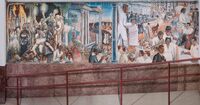 The History of the Negro in Education
The History of the Negro in Education Washington’s mural shows a timeline of Black education from left to right. On the left side of the mural, he depicts slavery and lynching above enslaved people secretly reading. In the center, girls write “Emancipation Proclamation;” next, Booker T. Washington delivers his "Atlanta Compromise" speech. The right shows emerging Black professionals.
-
 [unknown]
[unknown] McCowan’s mural portrays the brutality of war in the mid-twentieth century. Cold War-era themes of scientific and technological competition and atomic weapon fears appear. Inspired by Dr. Biggers’ philosophy of mural painting, McCowan integrates the wall’s architectural elements (a fire hose and extinguisher) to highlight the tension of the scene.
-
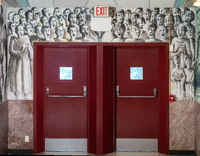 [unknown]
[unknown] Hatter’s mural shows a full church choir of men, women, and children singing passionately. Hatter chose this location for his mural to make use of the arching shape of the doorway, similar to the arrangement of a choir standing on risers. The white panel in the middle is where the exit sign once was located; Hatter used it as a lamp in the design.
-
 [unknown]
[unknown] McNeil’s mural depicts Christian themes. Christian iconography of the cross, lamb, wine, and dove appear in the composition. The design subverts classical Christian art by inserting everyday Black people in stained-glass style, instead of highly stylized, white saints. McNeil took pride in painting the first cross in Hannah Hall.
-
 [unknown]
[unknown] Cleinmann's mural reflects the past, present, and future, with an emphasis on the importance of Black women. This is a manifestation of Dr. Biggers’ teachings. This mural is one of few unfinished murals left standing in Hannah Hall; typically, unfinished murals would be painted over to allow another student to decorate the wall.
-
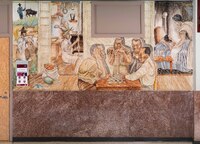 [unknown]
[unknown] Ross' mural captures a snapshot of Black rural life in the twentieth century. Outside, two men are ranching, while others play checkers on the porch. Inside, one woman is cooking in the kitchen while another cares for a child in bed. The composition also highlights the gendered division of labor, and how women’s work is often pushed to the margins.
-
 [unknown]
[unknown] Across two panels, separated by a mural, Oliver’s mural uses crosshatched, dark green hues to depict a woman and child (together) and a man (separate). Almost all art students painted only one mural; Oliver was an exception. Because of his enthusiasm and talent, he painted several murals, often using small spaces between other students’ works.
-
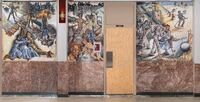 [unknown]
[unknown] Gaston Micheaux, was a war veteran who was given the opportunity in his first year of study to paint a mural. Reflecting on the devastation of the most recent world war, three panels depict terror, hunger, and human compassion. A scared, Black woman with children evokes the mid-20th century atmosphere of threat to Black life in America.
-
 3rd Ward
3rd Ward Taylor's mural captures a snapshot of Houston’s Third Ward in the mid-20th century. An ad for Big Mama Thornton’s Harlem Stars’ performance at City Auditorium indicates that Houston is the setting. The scene is a busy and varied one; people in various sorts of dress walk around, while children play in the streets and a derelict man sits by a tree.
 Birth of the Expression Burley’s mural explores cycles of life and centers women. The left side conveys night, with a constellation of a woman stretching across the sky. The right side shows daytime, with natural imagery of a horse, corn, and cotton. A rainbow stretches across the whole mural, signifying unity and togetherness. This is reminiscent of Biggers’ "Web of Life."
Birth of the Expression Burley’s mural explores cycles of life and centers women. The left side conveys night, with a constellation of a woman stretching across the sky. The right side shows daytime, with natural imagery of a horse, corn, and cotton. A rainbow stretches across the whole mural, signifying unity and togetherness. This is reminiscent of Biggers’ "Web of Life." Family Scene Sifuentes' shows multiple generations of a family, painted in a geometric style. The scene depicts parents and grandparents caring for children, with deceased ancestors (painted with angel wings) looking over them. Sifuentes borrows visual symbols from Dr. Biggers in this piece, including the tortoise (longevity) and the serpent (danger).
Family Scene Sifuentes' shows multiple generations of a family, painted in a geometric style. The scene depicts parents and grandparents caring for children, with deceased ancestors (painted with angel wings) looking over them. Sifuentes borrows visual symbols from Dr. Biggers in this piece, including the tortoise (longevity) and the serpent (danger). My Life After the Death of My Mother Samples’ mural unfolds like a dream, with each panel above the central figure (the artist himself), who is asleep on a table, revealing a constellation of scenes from the artists’ youth. Lower window panels evoke a harmonious existence with nature and animals, while upper panels reveal struggles with racism in the South and his mother’s death.
My Life After the Death of My Mother Samples’ mural unfolds like a dream, with each panel above the central figure (the artist himself), who is asleep on a table, revealing a constellation of scenes from the artists’ youth. Lower window panels evoke a harmonious existence with nature and animals, while upper panels reveal struggles with racism in the South and his mother’s death. The Rape of Mother Nature Jones’ mural shows an image of Mother Nature being attacked by oil derricks, pollution, and industrialization. This piece was painted during an explosion of oil drilling expansion throughout Texas. Nature is essential to Jones’ artistic practice; nowadays he creates wood carvings with reclaimed lumber from trees that fall during storms.
The Rape of Mother Nature Jones’ mural shows an image of Mother Nature being attacked by oil derricks, pollution, and industrialization. This piece was painted during an explosion of oil drilling expansion throughout Texas. Nature is essential to Jones’ artistic practice; nowadays he creates wood carvings with reclaimed lumber from trees that fall during storms. Architecture Lacy’s mural illustrates houses from a variety of different civilizations and cultures. The center structure which appears to have a face is a depiction of the terracotta sculpture she created under the instruction of Professor Carroll Harris Simms. In the upper left there is a moon with a basket of eggs, symbolizing fertility and new life.
Architecture Lacy’s mural illustrates houses from a variety of different civilizations and cultures. The center structure which appears to have a face is a depiction of the terracotta sculpture she created under the instruction of Professor Carroll Harris Simms. In the upper left there is a moon with a basket of eggs, symbolizing fertility and new life. Awakening Gordon’s mural shows the artist in various stages of her creative process, reflecting the influence of her TSU art professors. In the composition, she portrays herself sculpting a terracotta bison, throwing pottery at a wheel, weaving at a loom, and drawing at an easel. A wispy fabric runs through the mural, a motif in some of her other works.
Awakening Gordon’s mural shows the artist in various stages of her creative process, reflecting the influence of her TSU art professors. In the composition, she portrays herself sculpting a terracotta bison, throwing pottery at a wheel, weaving at a loom, and drawing at an easel. A wispy fabric runs through the mural, a motif in some of her other works. [unknown] This mural by an unknown student artist reflects themes of emancipation and progress. The central figure of a shirtless Black man raises his fist, while broken chains dangle from his waist. Bales of cotton and chains signify slavery in the mural, while, on the right, Black men in various professions represent changes brought by emancipation.
[unknown] This mural by an unknown student artist reflects themes of emancipation and progress. The central figure of a shirtless Black man raises his fist, while broken chains dangle from his waist. Bales of cotton and chains signify slavery in the mural, while, on the right, Black men in various professions represent changes brought by emancipation. [unknown] Jones’ surrealist Hannah Hall mural depicts bald, one-eyed men conducting a television broadcast. The artist incorporated Hannah Hall’s architecture into the design, as the beige panel, where the camera lens would be, was a glass transom window when the mural was painted. Dr. Biggers urged students to carefully consider where to paint their murals.
[unknown] Jones’ surrealist Hannah Hall mural depicts bald, one-eyed men conducting a television broadcast. The artist incorporated Hannah Hall’s architecture into the design, as the beige panel, where the camera lens would be, was a glass transom window when the mural was painted. Dr. Biggers urged students to carefully consider where to paint their murals. [unknown] Mills’ Hannah Hall mural reflects on white supremacist violence in the US and Black activism. Key political figures like Martin Luther King, Jr., Stokely Carmichael, John F. Kennedy, and Robert F. Kennedy appear throughout the mural. In the center, a man either lifts or pulls down the American flag to reveal or conceal hidden white supremacists.
[unknown] Mills’ Hannah Hall mural reflects on white supremacist violence in the US and Black activism. Key political figures like Martin Luther King, Jr., Stokely Carmichael, John F. Kennedy, and Robert F. Kennedy appear throughout the mural. In the center, a man either lifts or pulls down the American flag to reveal or conceal hidden white supremacists. [unknown] Heliton's mural captures the emotion and environment of a mid-20th century jazz club. Vocalists, a bassist, trumpeters, and a saxophonist are depicted in a fervent state of artistry. Heliton chose a corner spot for his mural, which lends a sense of depth to the piece, similar to how a jazz band would be physically arranged.
[unknown] Heliton's mural captures the emotion and environment of a mid-20th century jazz club. Vocalists, a bassist, trumpeters, and a saxophonist are depicted in a fervent state of artistry. Heliton chose a corner spot for his mural, which lends a sense of depth to the piece, similar to how a jazz band would be physically arranged. The Castration of Humanity Davis’ mural is a commentary on the conflict between technology & progress and history & culture. African statues are shown with their genitalia replaced by machines. Davis painted this mural in response to the destruction of several Hannah Hall murals for windows looking into a new computer lab. He foresaw that his own mural may also be damaged.
The Castration of Humanity Davis’ mural is a commentary on the conflict between technology & progress and history & culture. African statues are shown with their genitalia replaced by machines. Davis painted this mural in response to the destruction of several Hannah Hall murals for windows looking into a new computer lab. He foresaw that his own mural may also be damaged. Katrina Jazz Green fled New Orleans following Hurricane Katrina and then became a Texas Southern art student. His mural’s quintessentially New Orleans themes are linked by floodwaters running throughout the composition. It features baby Moses about to be floated down the Nile, enslaved people at a market, the Creole river goddess Mami Wata, and the Superdome.
Katrina Jazz Green fled New Orleans following Hurricane Katrina and then became a Texas Southern art student. His mural’s quintessentially New Orleans themes are linked by floodwaters running throughout the composition. It features baby Moses about to be floated down the Nile, enslaved people at a market, the Creole river goddess Mami Wata, and the Superdome. The History of the Negro in Education Washington’s mural shows a timeline of Black education from left to right. On the left side of the mural, he depicts slavery and lynching above enslaved people secretly reading. In the center, girls write “Emancipation Proclamation;” next, Booker T. Washington delivers his "Atlanta Compromise" speech. The right shows emerging Black professionals.
The History of the Negro in Education Washington’s mural shows a timeline of Black education from left to right. On the left side of the mural, he depicts slavery and lynching above enslaved people secretly reading. In the center, girls write “Emancipation Proclamation;” next, Booker T. Washington delivers his "Atlanta Compromise" speech. The right shows emerging Black professionals. [unknown] McCowan’s mural portrays the brutality of war in the mid-twentieth century. Cold War-era themes of scientific and technological competition and atomic weapon fears appear. Inspired by Dr. Biggers’ philosophy of mural painting, McCowan integrates the wall’s architectural elements (a fire hose and extinguisher) to highlight the tension of the scene.
[unknown] McCowan’s mural portrays the brutality of war in the mid-twentieth century. Cold War-era themes of scientific and technological competition and atomic weapon fears appear. Inspired by Dr. Biggers’ philosophy of mural painting, McCowan integrates the wall’s architectural elements (a fire hose and extinguisher) to highlight the tension of the scene. [unknown] Hatter’s mural shows a full church choir of men, women, and children singing passionately. Hatter chose this location for his mural to make use of the arching shape of the doorway, similar to the arrangement of a choir standing on risers. The white panel in the middle is where the exit sign once was located; Hatter used it as a lamp in the design.
[unknown] Hatter’s mural shows a full church choir of men, women, and children singing passionately. Hatter chose this location for his mural to make use of the arching shape of the doorway, similar to the arrangement of a choir standing on risers. The white panel in the middle is where the exit sign once was located; Hatter used it as a lamp in the design. [unknown] McNeil’s mural depicts Christian themes. Christian iconography of the cross, lamb, wine, and dove appear in the composition. The design subverts classical Christian art by inserting everyday Black people in stained-glass style, instead of highly stylized, white saints. McNeil took pride in painting the first cross in Hannah Hall.
[unknown] McNeil’s mural depicts Christian themes. Christian iconography of the cross, lamb, wine, and dove appear in the composition. The design subverts classical Christian art by inserting everyday Black people in stained-glass style, instead of highly stylized, white saints. McNeil took pride in painting the first cross in Hannah Hall. [unknown] Cleinmann's mural reflects the past, present, and future, with an emphasis on the importance of Black women. This is a manifestation of Dr. Biggers’ teachings. This mural is one of few unfinished murals left standing in Hannah Hall; typically, unfinished murals would be painted over to allow another student to decorate the wall.
[unknown] Cleinmann's mural reflects the past, present, and future, with an emphasis on the importance of Black women. This is a manifestation of Dr. Biggers’ teachings. This mural is one of few unfinished murals left standing in Hannah Hall; typically, unfinished murals would be painted over to allow another student to decorate the wall. [unknown] Ross' mural captures a snapshot of Black rural life in the twentieth century. Outside, two men are ranching, while others play checkers on the porch. Inside, one woman is cooking in the kitchen while another cares for a child in bed. The composition also highlights the gendered division of labor, and how women’s work is often pushed to the margins.
[unknown] Ross' mural captures a snapshot of Black rural life in the twentieth century. Outside, two men are ranching, while others play checkers on the porch. Inside, one woman is cooking in the kitchen while another cares for a child in bed. The composition also highlights the gendered division of labor, and how women’s work is often pushed to the margins. [unknown] Across two panels, separated by a mural, Oliver’s mural uses crosshatched, dark green hues to depict a woman and child (together) and a man (separate). Almost all art students painted only one mural; Oliver was an exception. Because of his enthusiasm and talent, he painted several murals, often using small spaces between other students’ works.
[unknown] Across two panels, separated by a mural, Oliver’s mural uses crosshatched, dark green hues to depict a woman and child (together) and a man (separate). Almost all art students painted only one mural; Oliver was an exception. Because of his enthusiasm and talent, he painted several murals, often using small spaces between other students’ works. [unknown] Gaston Micheaux, was a war veteran who was given the opportunity in his first year of study to paint a mural. Reflecting on the devastation of the most recent world war, three panels depict terror, hunger, and human compassion. A scared, Black woman with children evokes the mid-20th century atmosphere of threat to Black life in America.
[unknown] Gaston Micheaux, was a war veteran who was given the opportunity in his first year of study to paint a mural. Reflecting on the devastation of the most recent world war, three panels depict terror, hunger, and human compassion. A scared, Black woman with children evokes the mid-20th century atmosphere of threat to Black life in America. 3rd Ward Taylor's mural captures a snapshot of Houston’s Third Ward in the mid-20th century. An ad for Big Mama Thornton’s Harlem Stars’ performance at City Auditorium indicates that Houston is the setting. The scene is a busy and varied one; people in various sorts of dress walk around, while children play in the streets and a derelict man sits by a tree.
3rd Ward Taylor's mural captures a snapshot of Houston’s Third Ward in the mid-20th century. An ad for Big Mama Thornton’s Harlem Stars’ performance at City Auditorium indicates that Houston is the setting. The scene is a busy and varied one; people in various sorts of dress walk around, while children play in the streets and a derelict man sits by a tree.